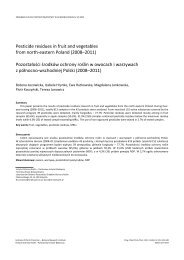Pełny tekst (PDF) - Progress in Plant Protection/Postępy w Ochronie ...
Pełny tekst (PDF) - Progress in Plant Protection/Postępy w Ochronie ...
Pełny tekst (PDF) - Progress in Plant Protection/Postępy w Ochronie ...
Create successful ePaper yourself
Turn your PDF publications into a flip-book with our unique Google optimized e-Paper software.
Nicienie i ich identyfikacja 1775<br />
STEFAN WOLNY, GRAŻYNA WINISZEWSKA,<br />
EWA DMOWSKA, TADEUSZ MALEWSKI<br />
NEMATODES CAUSING LOSS OF PRODUCTION PLANT IN POLAND<br />
AND METHODS OF THEIR RAPID IDENTIFICATION<br />
SUMMARY<br />
In Poland, it has been found so far about 260 species of plant and fungi parasitic nematodes.<br />
Among the nematodes feed<strong>in</strong>g on plants there are species that have the status of quarant<strong>in</strong>e pests.<br />
Before tak<strong>in</strong>g the decision to control nematodes, it is necessary to identify the pest species. The<br />
identification of nematodes is difficult because of the paucity of easily scorable diagnostic morphological<br />
characters. Consequently, molecular identification tools could solve this problem. For<br />
molecular identification of species are suitable different PCR-based methods, DNA barcod<strong>in</strong>g and<br />
DNA microarrays. The mitochondrial cytochrome oxidase c subunit 1 (COI) gene is one of the<br />
most popular markers for species identification across the animal k<strong>in</strong>gdom. Species identification<br />
based on COI sequence received name DNA barcod<strong>in</strong>g. DNA microarrays, first created 20 years<br />
ago, are well established and able to differentiate hundreds of specimens simultaneously. Microarray<br />
technologies, which <strong>in</strong>volve hybridization of short specific probes to target DNA and<br />
subsequent detection of the hybridization signal, have been widely used as diagnostic tools.<br />
Key words: plant parasitic nematodes, taxonomy, quarant<strong>in</strong>e, rapid identification, DNA

















